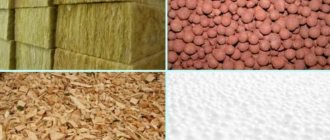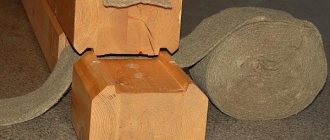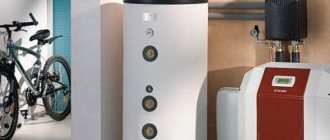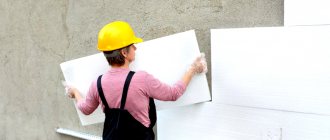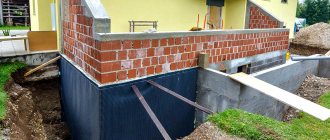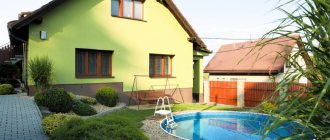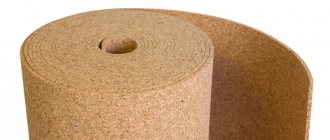Today we will tell you about bulk insulation, which is available in eight different types. The variety is simply impressive, as they are made from paper, stone, resin, polymers and even clay. Each material has its own strengths and weaknesses, although there are also those that there is nothing to praise for, even if one would like to. All bulk insulation can be installed using two methods: manually or using a compressor. Such materials are good because they fill all the cracks and voids. And negative qualities include shrinkage, which is inherent in all insulation materials from this cohort.
Method for preparing moistened fillings
Layers of binder and organic fillers are poured into the gap.
Then mix everything well and add water. After 3-5 weeks, the backfill in the structures dries with slight compaction and settlement. Drying time varies depending on air temperature. Such backfills should not be used in frame wooden buildings together with vapor barrier materials (roofing felt, roofing felt, glassine, etc.). They take a long time to dry out and sometimes cause fungus to form. As you know, fungus is very harmful to wood. Plates made from organic materials are considered better insulation. Their size should be 50×50 or 70×70 cm, and thickness from 5 to 10 cm. The ratio of components for their preparation:
- 1.5 parts quicklime + 0.3 parts cement + 2-2.5 parts water;
- or for 1 part by weight of organic filler take 4 parts clay dough + 0.3 parts cement + 2-2.5 parts water;
- or 1-2 parts of tripoliform clay + at least 0.7 parts of quicklime (fluff can be used) + 2-3 parts of water;
- or 1.5-2 parts of gypsum + 2-2.5 parts of water.
If lime paste is used, then the amount is doubled and the amount of water is reduced.
First, dry materials are mixed, then moistened with water and mixed again until smooth. After this, the mixture is placed in molds, leveled, the molds are removed and dried under a canopy or indoors. Drying time will depend on temperature conditions and the binder used. Plates made of gypsum, lime, and tripoli dry for 2-3 weeks, clay products - on average about 4-5 weeks.
Frame, frame-panel, panel walls and those walls that are mounted from elements manufactured at the factory are considered more economical.
A wooden frame is a kind of structure consisting of lower frames that are laid on the foundation. The elements of such a frame are connected with nails and bolts. If the frame is paved, then staples are used. The frame posts are sheathed with boards. The distance between the outer and inner cladding is filled with a special insulating backfill, straw or reed mats, or other slab insulation materials. For frame buildings manufactured at a factory, the outside of the plank cladding is often covered with cladding made of asbestos-cement sheets.
The popularity of insulation in the form of mats or slabs is understandable - they are easy to transport, convenient to work with, while saving time. But often builders use another type of thermal insulation - backfill. It differs from foam or mineral wool boards in its structure. It is possible that for some applications, backfill insulation will be more preferable.
The insulation is a low-density porous material, the granules of which are produced by firing foamed raw materials at high temperatures. The ease of manufacture is reflected in the low cost of thermal insulation, and the structure also allows saving on labor costs.
The disadvantages of fill-in insulation are:
- their shrinkage by 10-15% of the initial volume;
- loss of thermal insulation properties when wet.
Loose-fill insulation is usually used for horizontal surfaces. The work seems simple, but requires careful preparation. For example, when insulating floors in buildings without basements, the soil is first compacted and covered with screed. Next, waterproofing material is laid on the latter, and insulation is poured onto it. It looks like the situation is the same with roof insulation, but no screed is required. Instead, a layer of vapor barrier is laid on top of the backfill material.
When covering walls, a frame consisting of durable sheet elements is constructed in advance. After this, insulation is poured inside the resulting structure.
Installation
There are several basic rules for installing bulk materials. But each type has its own nuances, so experts recommend following the instructions with a complete technological description for filling this or that insulation.
Let's get acquainted with the general recommendations for the correct implementation of energy-saving cladding with bulk materials.
- Insulation of pitched roofs occurs from the outside after laying the vapor barrier. For good and uniform distribution of thermal insulation along the slope, it is necessary to install transverse stops.
- When insulating the floor and basement, after filling the raw material, it is important to compact it thoroughly. This is done to avoid shrinkage of the insulation and subsequent deformation of the finish.
- When finishing rooms with high humidity, such as baths, saunas, a layer of fill insulation will require additional, high-quality hydro- and vapor barrier.
- Loose-fill heat insulators are laid in such a way as to prevent them from spilling through cracks and cracks in the finishing.
Bulk insulation can be used to fill any space in building structures. This type of insulation does not lead to disruption of the main finish and its structure. Therefore, if it is impossible to insulate with traditional slabs or rolls, bulk materials will come in handy.
Thanks to the huge assortment of backfill thermal insulation materials, the consumer is given the opportunity to make an independent decision in favor of choosing one or another raw material.
For an overview of perlite bulk insulation, see the following video.
Settlement of dry backfills
The main disadvantage of dry fill is that it settles and creates voids. Therefore, if they are used, the walls are erected 20-30 cm above the level of the ceiling beams, completely filled with backfill. As the backfill settles, it will fill the empty space. Under the windows, it is better to replace the backfill with fiber or tile materials. If there are none, install retractable window sills to add backfill through them.
To make the insulating backfill less friable, materials should be added to it that will turn it into a solid filler. For example, we take 85% sawdust and mix it with 10% fluff lime and 5% gypsum. In this case, the sawdust will harden and turn into the so-called thermolite. For such a mixture, wet organic materials or sawdust that have not undergone special drying are used. The sawdust is mixed with fluff, then this mixture is added to the plaster and immediately laid out in place, leveling and compacting well. The moisture present in the filler will slightly moisten the plaster and it will set. The filler will turn into a loose mass, thicken, and thanks to this it will not settle.
Types of backfill thermal insulation
Hundreds of years ago, in the construction of wooden houses from timber or logs, the very first fill-in insulation was used - sawdust. Like modern analogues, they were quite good in terms of thermal conductivity, but they shrink or lose their properties when wet. Today's materials are more advanced in many ways. The most popular of them are discussed in detail below.
Insulation based on clay. It is used as an independent heat insulator for residential or industrial buildings, or in combination with concrete (expanded clay concrete is obtained). Today it is obtained by burning clay shale.
Production technology varies depending on the required size of the final granules.
By studying the labeling of the fill-in insulation, you can understand what size granules of the material are and for what areas of the house it is suitable. For example, expanded clay sand is used as a heat insulator for floors or acts as a component of concrete cladding. Granules with a diameter of 5-10 mm are suitable for pitched and flat roofs, floors, and attics; larger than 15 mm - for insulating a basement or foundation.
Expanded clay inevitably settles as it is used, so during initial installation it must be compacted strongly to minimize shrinkage. It is recommended to insulate walls with this material only in regions where the temperature in winter does not drop below −20 degrees.
The insulation is made from silicate volcanic rocks using the same technology as expanded clay. When heated to 1000-1200 degrees, moisture evaporates from the surface of the stones, leaving air inside them. The result is white or gray granules with a diameter of 1 to 10 mm. The density of perlite ranges from 75 to 150 kg/m3, and because of its color it is also called “glass insulation.”
Minimum size granules (1-2 mm) form perlite sand, used in the following areas:
- insulation of premises of residential buildings;
- production of acoustic materials;
- production of insulating plaster;
- creation of fire-resistant concrete.
Granules filled with air weigh less than expanded clay, so they are suitable for thermal insulation of walls. In addition, the material will resemble mineral wool, since in addition to preserving heat, it will prevent the penetration of extraneous noise into the room.
Expanded material made of hydrated mica, increased in volume by 15-20 times through heat treatment. It has increased fire-resistant properties, due to which it is used when installing chimneys. Ideal for floors and walls.
A thin layer of vermiculite 5 cm thick will retain up to 70% of the heat of the room. This is enough to insulate the roof. For walls, floors and foundations, it is recommended to make twice as much material.
The density of vermiculite is lower than that of expanded clay or perlite - the highest volumetric mass is 100 kg/m3. This fill-in insulation is supplied in bags of a certain volume, and is used in almost all rooms of a residential building.
The advantages of vermiculite include:
- low thermal conductivity coefficient (0.04-0.06), comparable to foam plastic and mineral wool;
- no possibility of voids and seams;
- high melting point (1400 degrees);
- absence of toxic materials;
- biological resistance (prevents mold, mildew, is not of interest to rodents);
- good sound insulation;
- the lightness of the material, allowing it to be used in frame houses, on supporting systems or foundations;
- ease of insulation work and time saving.
Ecowool.
A relatively new material that appeared on the market only 10 years ago. Made from recycled paper, fire retardants (substances that prevent fire), and antiseptics. Safe for humans, resistant to rotting, and does not spread fire. It is most often used for thermal insulation of walls, attics or roofs of complex construction.
Bulk insulation for walls and ceilings
To ensure that your home is always warm, cozy and comfortable, you need to insulate the outer walls of the house. For such purposes, bulk insulation can be used. Let's start our review of such options with foam glass. This is a modern granular and 100% ecological material. Foam glass is obtained from raw fractions by foaming. This insulation is excellent for insulating walls. In addition to excellent thermal insulation properties, foam glass can be the basis for thermal insulation plaster. The material is not afraid of moisture. Let's look at other options that can be found on the building materials market today.
Insulating the floor of a house with expanded clay
Expanded clay is one of the most suitable materials for, especially if the budget is limited. Insulation can be performed using one of several existing methods.
Classic version
provides the following sequence of actions:
You can do without the labor-intensive process of preparing the mortar and pouring the screed using simplified dry technology
:
- a vapor barrier is laid on the surface of the main floor;
- Expanded clay is poured over the beacons; for reliability, it can, of course, be fixed with cement laitance;
- Dense gypsum fiber sheets are laid on the expanded clay, which are held together with glue.
The dry method is also similar to the insulation option using joists:
Roofs
Insulation of a pitched roof with expanded clay is rarely carried out, but the technology is simple:
- boards are packed along the bottom of the rafters, forming a plane on which the insulation will be poured;
- A vapor barrier film made of polyethylene is laid overlapping. It has several functions: vapor and waterproofing, preventing small fractions of pellets from spilling through the cracks between the boards;
- Ceramic granules are poured over the film in an even layer;
- the thermal insulation layer is covered with a vapor barrier membrane;
- a counter-lattice is filled to create a ventilation gap;
- boards are attached on top of the counter-lattice to secure the roofing material;
- the roof is being installed.
Advantages and disadvantages
Bulk types of insulation in most cases belong to environmentally friendly insulation (if natural materials were used in the production process). For example, perlite or perlite crushed stone is cast from glass of volcanic origin. Vermiculite also has a mineral origin - granules are formed during the heat treatment of certain rocks. Polystyrene (polymer insulation) does not have such characteristics - its granules begin to release styrene into the environment during long-term operation.
Operational advantages of mineral insulation:
- They allow steam to pass through perfectly, preventing the walls from becoming damp;
- serve for a long time without loss of technical characteristics;
- resistant to open fire - can withstand temperatures from 1,000 degrees;
- not interested in rodents and insects;
- do not collapse under the influence of high humidity;
- do not lose their shape - granules or crushed stone do not split over time.
The disadvantages include the need to construct an additional partition (the insulation is poured between the facing material and the wall). Which, as a result, requires expanding the foundation.
Basic elements of frame walls
Frame includes:
- top harness;
- bottom trim;
- walls;
- braces (struts) of rigidity;
- additional components such as intermediate crossbars and racks.
Door and window openings are constructed between the posts.
When building two-story houses, you can use two main types of frames:
- With floor racks (when one house seems to stand on another). This type of frame is easier to build because it allows the use of smaller material.
- With through racks on two floors. This type of frame is more stable. Long material is used for it.
The supporting racks of the frame are mounted at intervals of 0.5-1.5 m, focusing on the desired size of doors and windows. Ordinary frame posts are made from boards measuring 5×10 cm or 6×12 cm. Corner frame posts are made from composite boards or beams.
The base of the frame is the lower frame. It is made up of logs, boards or beams. The corners of the bottom trim are made using the “straight half-tree lock” technique. If floor beams are cut into the frame, then it is made of two crowns. If the floor beams simply rest on the pillars, then the frame is made from one crown. Usually the frame elements are fixed with nails, sometimes spikes are used.
To make the frame more stable, plank struts are attached on both sides between the posts. They are cut flush using a frying pan or semi-frying pan. The upper trim is fixed on top of the racks and the ceiling beams are cut into it. It is best to attach the top harness to straight spikes. Next, rafters are placed on the beams. Sometimes log (cobblestone) beams are replaced with boards (planks) with a section of 5x18 cm or 5x20 cm and placed on edge. From the outside, the assembled frame is covered with wooden planks and nailed to the posts with nails measuring 7-7.5 cm. The thickness of the boards is 2-2.5 cm. They can be replaced with asbestos-cement slabs or any other materials that are durable and resistant to precipitation.
Features of internal thermal insulation
When placing insulation from the inside is the only solution, the installation process and choice of material must be approached responsibly, taking into account all the recommendations of specialists.
What is “dew point” and why should it be taken into account? This is the place where room steam turns into condensate at a certain temperature. With external insulation, the wall is heated by heating devices, and is protected from external influences by thermal insulation material.
In this case, the dew point appears in the thickness of the wall, and its surface remains dry. If insulation is placed inside, the structure freezes and moisture appears when it comes into contact with steam. The only way to prevent dampness and fungal growth is to use a vapor-proof material. The dew point will remain inside, but moisture will not flow to it and the wall will remain dry.
Advantages of bulk insulation
High-quality home insulation is the basis for a comfortable stay. Therefore, it is important to pay enough attention to the material before choosing insulation. Bulk heat insulators have the following positive characteristics:
- minimal heat loss;
- resistance to sudden temperature changes;
- minimum weight;
- environmental friendliness;
- Fire safety;
- long service life;
- ability to retain heat for a long time;
- ease of installation.
To insulate walls with bulk basalt wool or other bulk insulation, no special tool is required. All work can be done by a home craftsman without the help of professionals.
It is important to pay attention to the manufacturer of thermal insulation materials. A popular Russian company supplying quality products is Ecover.
Expanded clay production and fractions
For the production of expanded clay, low-melting clays
with a quartz content of 30%. They are processed in special chambers, where they are heated to a temperature of 1050-1300 0 C for 30-40 minutes, resulting in swelling and the formation of porous granules with a melted hermetic shell, which gives the material the necessary strength. The more pores in expanded clay, the better.
During the production process, as a rule, granules of different fractions are obtained:
- expanded clay sand
with granule size up to 5 mm; - expanded clay crushed stone
- granules resembling cubes in shape; - expanded clay gravel
– oblong shaped granules.
Based on the size of the granules, expanded clay is divided into the following fractions: 5-10 mm, 10-20 mm and 20-40 mm.
Foundation
The foundation needs thermal insulation to prevent annual temperature fluctuations. The technology for its protection by filling with expanded clay is as follows:
- A trench is dug around the finished foundation with a depth corresponding to the amount of soil freezing. The trench width is at least 50 cm.
- In the resulting cavity, formwork is placed from available materials (boards, slate sheets).
- Waterproofing work is carried out on the bottom and side surfaces (film, roofing felt, etc.).
- Expanded clay gravel is filled to zero level and compacted. The surface is leveled.
- The insulation on top is also insulated from moisture.
- Then a blind area is made around the foundation or a thin layer of soil is poured.
Features of the material
There are several types of bulk material for insulation. Each of them has its own properties. List of bulk insulation materials:
- expanded clay;
- polystyrene foam in granules;
- foam concrete crumbs;
- ecowool;
- sawdust and sand;
- boiler slag;
- vermiculite
Expanded clay
The usual form of this material is round or oval granules. Granules or other shaped material are porous and very light (some types can float on the surface of the water). Expanded clay is formed by firing light alloy clay. It is absolutely non-flammable, safe, and environmentally friendly in its composition.
The material can be in three forms:
- sand with grain size from 0.14 to 5 mm. It is used as a filler for lightweight concrete and for floor insulation;
- Expanded expanded clay crushed stone is granules with a fraction of 5–40 mm. The best option for thermal insulation of foundations and floors of residential premises;
- expanded clay gravel. Round granules 5–40 mm with a fused surface, absolutely resistant to fire. They have closed pores inside, which gives them excellent frost resistance. This gravel is recommended for insulating attic floors: the material is lightweight and has low thermal conductivity.
The labeling of a material must include the size of its fraction:
- 5–10 mm – floors and roofs;
- 10–20 mm – baths and saunas, able to maintain temperature and humidity in the room for some time;
- more than 20 mm - for foundations and basements.
Expanded polystyrene granules
This is the most controversial bulk material. It is a very light, airy white granule. It is used as backfill for insulating roofs and walls; it is also used as an additive in mixtures for insulating concrete.
The disadvantages are toxicity and flammability, but its properties have not yet been fully studied. Instead, it is recommended to use granulated foam glass. Expanded polystyrene is cheap and convenient for insulation using the well-laying method.
Vermiculite
This is a mica-based layered material. No chemical additives or impurities are used in the manufacturing process. It is an excellent option for insulating loggias and rooms. Used as an energy-saving cladding for housing inside and outside. For floors and walls, a layer of at least 10 cm is recommended, for the roof - at least 5 cm. Backfilling with this material 5 cm thick reduces heat loss by 75%, 10 cm - 92%.
- high breathability of insulation - the material is porous - which allows the walls to “breathe”, ideal for natural circulation, air renewal and ensuring a microclimate in the room;
- environmentally friendly, without toxic substances;
- non-flammable, fire-resistant, belongs to the G1 flammability group;
- fungi, mold, rodents, insects are not afraid of such isolation;
- special skills or experience, special tools are not needed to fill it. The layer of material is simply poured back and compacted. No additional fasteners are needed;
- service life - more than 50 years.
For walls, a vermiculite backfill thickness of 10 cm is sufficient, for attics, roofs, and interfloor ceilings – 5 cm. When laying, it is advisable to use a vapor barrier film - this will additionally protect the insulation from moisture.
Sawdust and sand
These are traditional heat preservation materials that are used in attics and basements and have been used for centuries. Disadvantages: they are poorly insulated from moisture, pests can grow in them. Sawdust is flammable and susceptible to mold and mildew. It is still recommended to use more modern materials.
For insulation, they use not ordinary sand, but perlite. It is light weight, less hygroscopic, and its characteristics resemble mineral wool. Due to its low bulk density, it does not create a load on the walls and does not burst them.
Ecowool or cellulose
The components of this insulation are ecowool (7%), shredded paper (81%), antiseptics (12%) and fire retardants (7%). The material is non-flammable and does not rot thanks to special impregnations. It has been used in the world for more than 80 years; it has been known in the CIS for the last decade.
This material uses boric acid as an antiseptic and borax as a fire retardant. These substances are environmentally friendly.
Loose thermal insulation ecowool
Ecowool was developed as part of a waste recycling program.
This type of insulation was developed in Europe as part of a recycling program. That is, the main goal is to usefully recycle waste. It is made exclusively from newspapers; no more than 10% cardboard is allowed. To prevent ecowool from burning, microorganisms from growing in it, and mice not gnawing on it, borax and boric acid are added to the detailed newsprint.
It is used as bulk insulation for floors and walls, installation is carried out using dry and wet methods. The density when blown by machine is 65 kg/m in the wall. cube, on floors 45 kg/m. cube, density for manual laying - up to 90 kg/m. cube Thanks to fire retardants, the material does not burn, but smolders successfully.
The service life of ecowool produced in the Omsk and Tomsk regions is 10–12 years. Western manufacturers claim that the material will last 50 years. But they give such forecasts based on the climatic conditions of their region, where temperature differences are smaller and, accordingly, less moisture settles in the insulation (due to the dew point). For Russia, with its cold and humidity, these forecasts are unlikely to come true.
The thermal conductivity of ecowool is 0.037–0.042 W/m*C. It easily absorbs moisture and releases it just as easily.
When wet, it becomes heavier, which leads to shrinkage, which is inevitable. In fact, ecowool has nothing to do with environmental friendliness. It is simply stuffed with chemicals and we do not recommend using it.
For walls
To maintain heat in the house, you need to insulate not only the floor, but also the walls.
And not only from the inside, but also from the outside. There is a large selection of insulation materials, but you want to choose the best one. To do this, you need to familiarize yourself with the characteristics of insulation and choose the one that is most suitable. The following materials are widely used for wall insulation:
The list of insulation materials is presented in a very wide range. Bulk insulation materials are still in great demand. The same old proven insulation materials that are used for floors have proven themselves to be excellent. More modern ones have also appeared. For example, foam glass is very popular among builders.
This environmentally friendly material is chemically stable and does not undergo biological destruction. Granulated foam glass is used not only as an independent backfill, but also as the basis for heat-insulating plaster. It is obtained from foamed raw granules. It is produced in the form of slabs, crushed stone and in granular form of various fractions.
It is worth noting: granulated foam glass is absolutely not afraid of groundwater. Therefore, in addition to walls, it can be safely used for insulating foundations and basements.
Penoplex - granules made of foamed polymers. Sold in the form of slabs or crumbs. Absolutely does not absorb moisture. Very light weight material. Requires protection from sunlight and chemical influences.
Please note: penoplex can only be used within the operating temperature range (from -50ᵒ C to +75ᵒ C).
For work on wall insulation, loose penoplex is very convenient. Especially when making walls of a frame structure. Containing very small granules (from 0.1 mm), it is able to penetrate into the smallest voids.
Expert advice: it is not recommended to use penoplex to insulate the walls of baths and saunas.
Mineral wool is widely used for insulating not only walls. Granule size from 10 mm. Has good vapor permeability. Fire resistant. Does not change its properties up to 1000ᵒ C. Good sound insulator. Recommended for internal insulation. Sold in bags, in bulk, in rolls. When working with mineral wool, it is necessary to take measures to protect the respiratory tract and skin.
Please note: wet mineral wool noticeably reduces its thermal insulation parameters. It is very difficult to dry. To summarize, we can confidently note that bulk insulation takes the leading place as insulation for walls
To summarize, we can confidently note that bulk insulation takes the leading place as insulation for walls.
Foam glass in granules
Fractions of foam glass come in different sizes, up to crushed stone.
It is made from broken glass, which is crushed into smallest fractions, melted and mixed with coal. As a result, carbon dioxide begins to escape from the material, which forms air spheres in the structure of the foam glass. This is a very expensive material; it is used in industrial facilities or in the construction of high-rise buildings. It is used extremely rarely in private construction, since not everyone can afford such a cost. They are used as bulk insulation for ceilings, floors and walls, and in the form of slabs or blocks. Bulk comes in different fractions, based on this, it looks like:
- granules;
- crushed stone
Bulk foam glass insulation has the following characteristics:
- does not absorb water;
- does not burn;
- thermal conductivity 0.04–0.08 W/m*C;
- does not allow steam to pass through;
- high compressive strength 4 MPa;
- bending strength is even more than 0.6 MPa;
- operating temperature range from -250 to +500 degrees.
The peculiarity of using bulk insulation for floors is that foam glass can be part of the cement mortars with which the screed is poured. The same is true when pouring foundations; instead of ordinary crushed stone, you can use foam glass.
Why is it necessary to include filters for gas boilers in the heater piping? Wiring diagram and installation methods.
Interested in installing a safety group for heating: video instructions here.
For floor
During any construction, the closest attention is paid to thermal insulation. Floor insulation has not been left without attention.
Bulk insulation materials are best suited for this.
The most common among them are:
Expanded clay in floor insulation is the most widespread insulating material. Low price, mass production and high thermal insulation properties played an important role in this. And, although it is made from clay, the resulting product is quite light. Weight of 1 m³ is on average 350 kg.
It is appropriate to mention that expanded clay is the most environmentally friendly material. It is not susceptible to moisture and at the same time frost-resistant. Sold in bags or in bulk. Expanded clay can be used as an independent insulation material or in combination with concrete. Expanded clay concrete not only retains heat, but in addition is a very durable substrate, foundation.
The next representative of bulk insulation will be perlite. Its origin is volcanic rocks.
A distinctive feature, unique to it, is a high percentage of moisture absorption. Research has shown that it is capable of absorbing four times its own weight in moisture. It is because of this that it is recommended for insulating rooms with high humidity.
Environmentally friendly natural material that does not enter into any chemical reactions. Has high fire resistance.
Withstands temperatures up to 900ᵒ C. Having a porosity of up to 40%, it is an excellent insulation material. For insulation it is used in the form of perlite sand. You can buy it in the same way as expanded clay, in bags or in bulk.
This is interesting: perlite is used not only in construction, it is also used to filter vegetable oil, fruit juices and beer.
Vermiculite is also an excellent natural insulation material. It is distinguished by its hardness. Along with high fire resistance (up to 1200ᵒ C), it has an impressive moisture absorption coefficient of more than 530%. It has amazing thermal insulation properties.
With a layer thickness of only 5 cm, heat loss is reduced by 75%. It is an environmentally friendly material. Has high chemical and biological resistance. Prevents the appearance of mold and mildew. Having a low volumetric weight, it does not create a load on the foundation. It is sold like all bulk insulation materials - in bags and in bulk.
For floor insulation, not only bulk insulation materials are used. Polystyrene foam, mineral wool, liquid insulation, cork and a number of others are also often used. Each of them has both positive and negative sides. Some are very good, but expensive. For example, cork insulation. Others, like polystyrene foam, are not fire resistant.
Good floor insulation is obtained from ordinary sawdust, but it requires special antiseptic treatment. In addition, it shrinks very quickly and cakes. Bulk insulation materials have the most optimal parameters for floor insulation.
Please note: loose insulation materials tend to shrink. Dense compaction reduces its size.
For ceilings
Just like floors and walls, ceilings require insulation.
The insulation materials discussed above may well be used in this case. A more specific insulation material is penoizol. In appearance it somewhat resembles foam chips. This is where the similarity ends, if you do not take into account the thermal conductivity characteristics.
Penoizol is absolutely not flammable. Has high chemical and biological resistance. Rodents avoid it. It is good for insulating ceilings because it is very light in weight. Its density is from 5 to 75 kg/m³. Due to low thermal conductivity, an insulation layer thickness of 5 cm or more is sufficient. When working, bulk material is used, in sheets and in liquid form.
When considering bulk insulation for ceilings, one cannot ignore such a widely used material as sawdust. Sawdust is used for insulation as the cheapest material. Their use as an independent insulation material is highly undesirable. The fact is that they are susceptible to rotting due to moisture absorption.
They are also excellent breeding grounds for mice. Even if you do not take into account the fact that they are a fire hazardous material, it is easy to conclude that they are unsuitable. “Craftsmen” go to all sorts of tricks in order to somehow reduce these negative factors. To do this, sawdust is mixed with expanded clay, lime, even broken glass and other building materials. Such measures somewhat improve the properties of the insulation, but not much.
Insulation of house walls with expanded clay
To insulate walls with expanded clay, a three-layer masonry method
, which is applicable only for newly built houses: the first layer is a load-bearing wall, the second layer is expanded clay with cement laitance, the third layer is external finishing. There are three technologies:
If the walls
, then expanded clay insulation must be compacted very carefully.
walls
with expanded clay. Since its thermal insulation properties are somewhat worse than those of its closest competitor, it is necessary to leave cavities 20-40 cm thick, and this is a significant load on the load-bearing walls, so an additional foundation will have to be made outside. The complexity of the technology and the cost of all additional manipulations practically nullify the cost-effectiveness of expanded clay insulation, so for wooden houses it is better to consider another option for wall insulation.
The main advantage of frame walls over log walls is that they require less wood to produce. Frame houses are always warm, have good sound insulation, and most importantly, they are easy to build.
Manufacturers
On the market you can find materials for insulation of domestic production, as well as insulation from the USA, Finland, Germany, France and other countries.
The following brands are available:
- TechnoNikol;
- Knauf;
- Isoroc;
- Isover;
- Paroc;
- Rockwool;
- Ruspanel;
- Soudal;
- Tytan;
- Ursa;
- Akterm;
- Penoplex;
- Penofol;
- Tepofol;
- Tilit;
- And others.
Go to any well-known online store and use filters to look at the characteristics of each individual product.
As you can see, there are very different methods of insulation, but price always remains an important issue.
Features of insulation with mineral wool
Although the material is not vapor-tight, it is often used for DIY internal insulation. Among the advantages of mineral wool:
- low thermal conductivity coefficient - 0.04-0.45;
- does not support combustion;
- basalt wool slabs are easy to install;
- affordable price;
- excellent sound insulation.
The insulation can be installed in residential and non-residential premises, for which cheaper glass wool is suitable. It is fireproof, resistant to frost, rodents and mold. The disadvantages of thermal insulation material are high hygroscopicity and vapor permeability. Mineral wool is used for DIY insulation of brick and concrete walls, but is not recommended for wooden houses.
Installation of thermal insulation is carried out using the following technology:
- The surface of the wall is covered with a layer of antifungal impregnation.
- Using a laser level, a line for attaching the starting profile along the entire perimeter of the future structure is outlined.
- A waterproofing sheet is laid and secured on the wall, extending to the floor and ceiling.
- According to the completed markings, the guide profile is fixed. After attaching it, the installation locations of vertical posts and hangers are marked. The pitch of the CD wall profile is 60 cm, this allows one 120 cm sheet of plasterboard to cover two cells and reduce the number of joints.
- To insulate the vertical surface, mineral wool in slabs is used. This material makes installation easier and does not shrink over time. The slabs must fit tightly into the designated sections, but not be crushed, otherwise their characteristics will deteriorate.
- A vapor barrier film is mounted on top of the insulation. It is recommended to use penofol - foamed polyethylene with a foil coating. The reflective layer will protect the room from heat loss and prevent steam from penetrating the mineral wool. A layer of foil is directed towards the room, the joints of the canvases are glued with special tape.
- The installation of plasterboard sheets completes the thermal insulation. They are attached to the galvanized profile with self-tapping screws.
The service life of the insulation is up to 10 years. When installing mineral wool, it is imperative to protect the skin, eyes and respiratory organs from small fibers.
Insulation of walls from the inside is carried out in exceptional cases
It is important to use a material with suitable characteristics and carefully seal the wall with a vapor barrier film. In order not to violate the integrity of the finish, it is not recommended to install sockets and switches on it
Backfilling process and its features
Thickness table for temperature conditions:
Recommendations
For backfilling there are the following recommendations. Firstly, bulk material settles over time, so it needs to be compacted well. It is advisable to use boiler slag and expanded clay in regions where winter temperatures do not drop below -20°C. Insulation of pitched roofs with expanded clay and similar compounds is carried out from the outside, after laying the vapor barrier. Transverse stops are installed along the slope between the rafters - they evenly distribute the insulation.
After laying it on the floor or in the basement, it is well compacted to prevent shrinkage and deformation of the finish. The only problem is moisture ingress; bulk insulation materials are quite hygroscopic. In baths and saunas and, indeed, everywhere, the insulation layer must have high-quality hydro- and vapor barrier. It is necessary to ensure that there are no cracks in the finishing and that bulk material does not spill through them. It is also worth remembering that expanded clay is quite heavy. It is necessary to ensure that its mass does not push apart too weak partitions or walls.
Characteristic
Bulk heat insulation is used not only for internal surfaces - it can also be used to insulate a room outside. Walls, floor, roof - you can insulate all elements that structurally allow the filling of material.
Loose fill insulation is cheap. Some of its types are simply industrial waste (sawdust) or ready-made natural materials (sand).
The only drawback is hygroscopicity. When wet, it loses its properties.
It is necessary to pay special attention to the hydro- and vapor barrier of its layers. However, the fear of moisture is characteristic to the same extent for all types of thermal insulation.
Scope of application of fill-in insulation
Since the material in question is light and hardly weighs down the structure, it is usually used when covering a sloping roof. It is also used for insulating the following areas of houses:
- attic floors;
- attics;
- frame structures (walls);
- floor, foundation;
- horizontal partitions between floors;
- brick walls.
The optimal combination of price, quality, as well as the combination of lightness with reliable thermal insulation contributed to the growth in demand for the considered fill-in insulation. If your home requires good protection from the cold, but there is little time for work, expanded clay, perlite, vermiculite and ecowool will be excellent helpers in the implementation of your plans.
https://youtube.com/watch?v=YmB-_dss9ow
Loose penoizol
Penoizol flakes have a random shape.
In appearance, penoizol looks like foam chips, but if you look more closely, the difference is obvious. Despite the visual similarity, these are two completely different materials. Penoizol is more reminiscent of snow flakes, it does not have an ideal ball shape, this material is softer. Penoizol is used as fill-in insulation for walls and horizontal ceilings. In addition, it is also available in sheets, but is mainly used in liquid form. Unlike polystyrene foam, penoizol:
- does not burn;
- does not smoke;
- allows moisture to pass through, but does not absorb it.
The thermal conductivity characteristics of both materials are almost equal.
Penoizol backfill insulation for walls is made from resin. The quality of the material primarily depends on the quality of the resin used for production.
First, the liquid substance is poured into blocks, about a meter by meter. Then the blocks are cut into sheets, and only then the sheets are crumbled. Installation is carried out using a blowing machine or manually. When working, you need to control the degree of density of the material.
